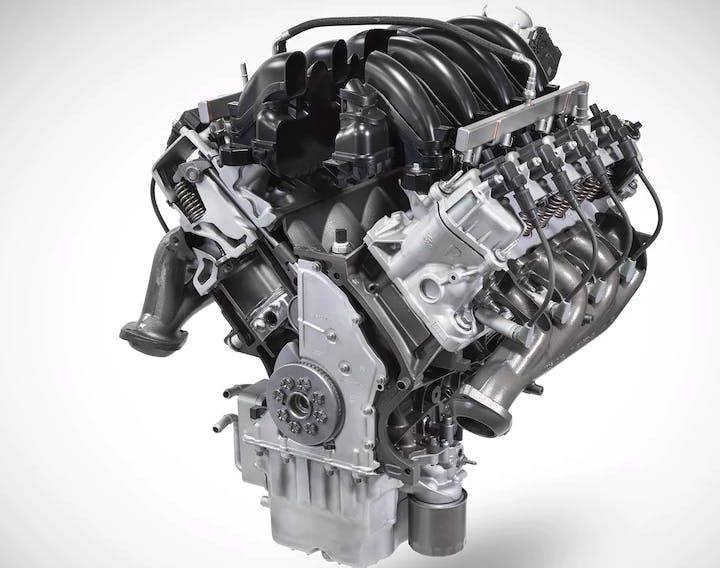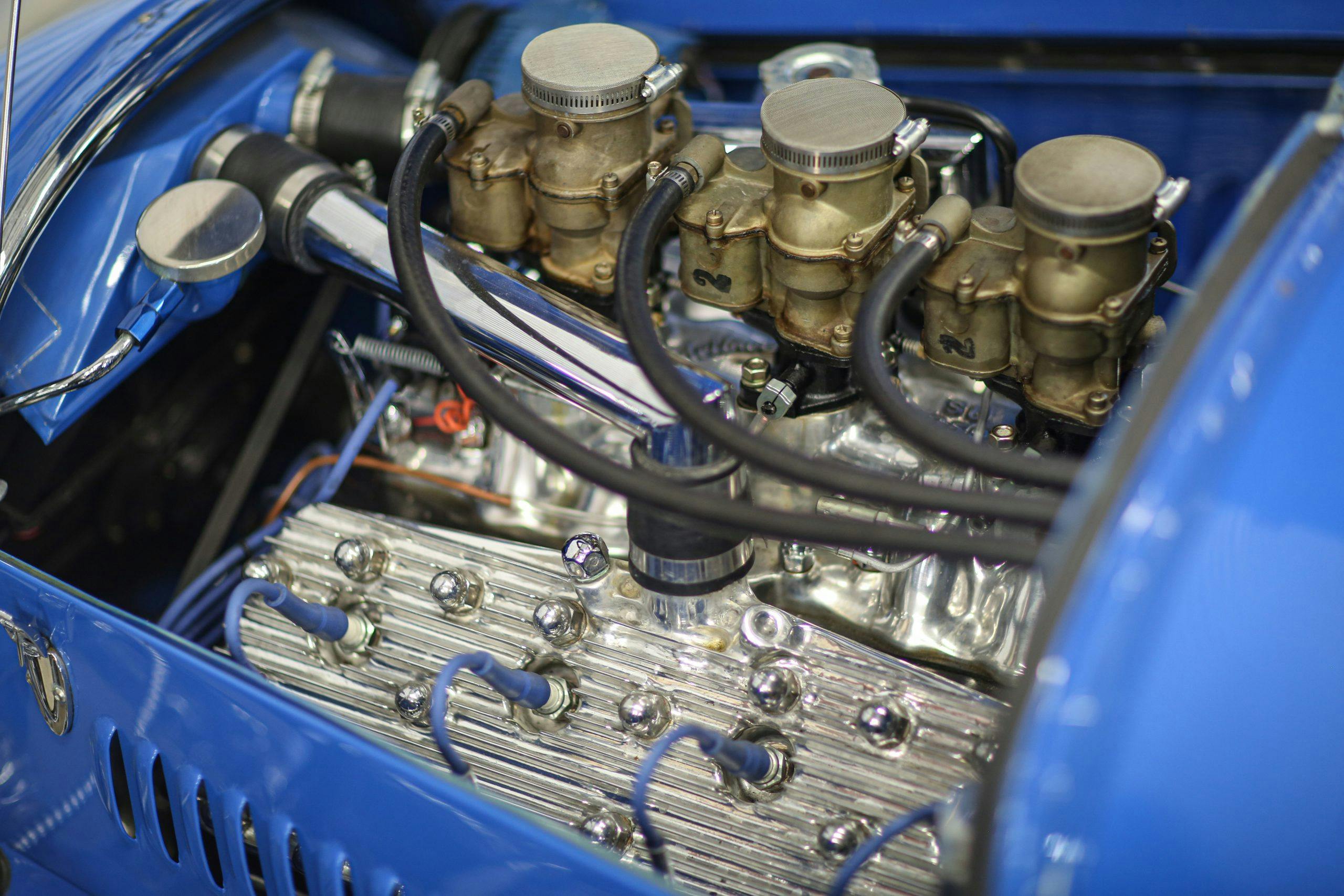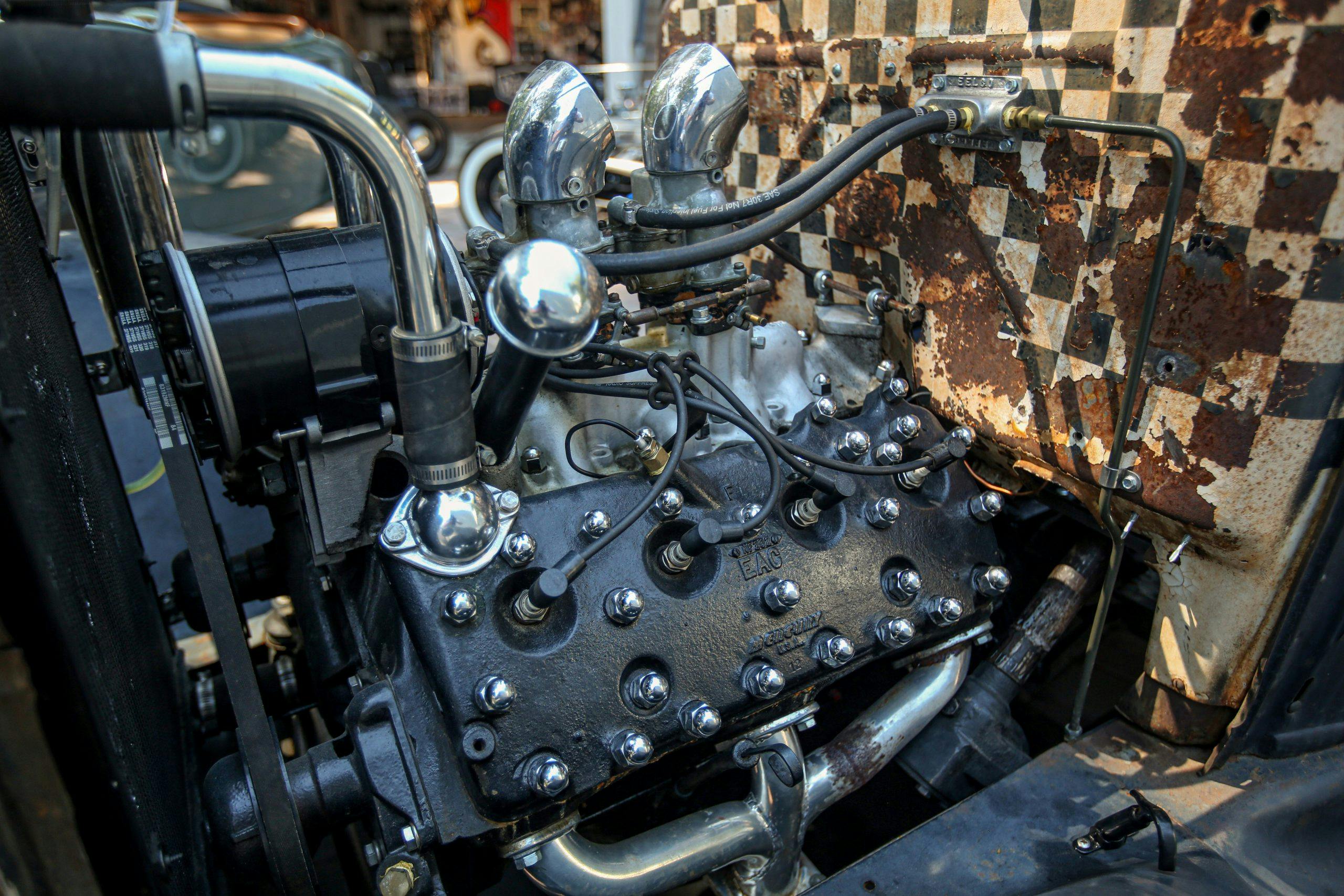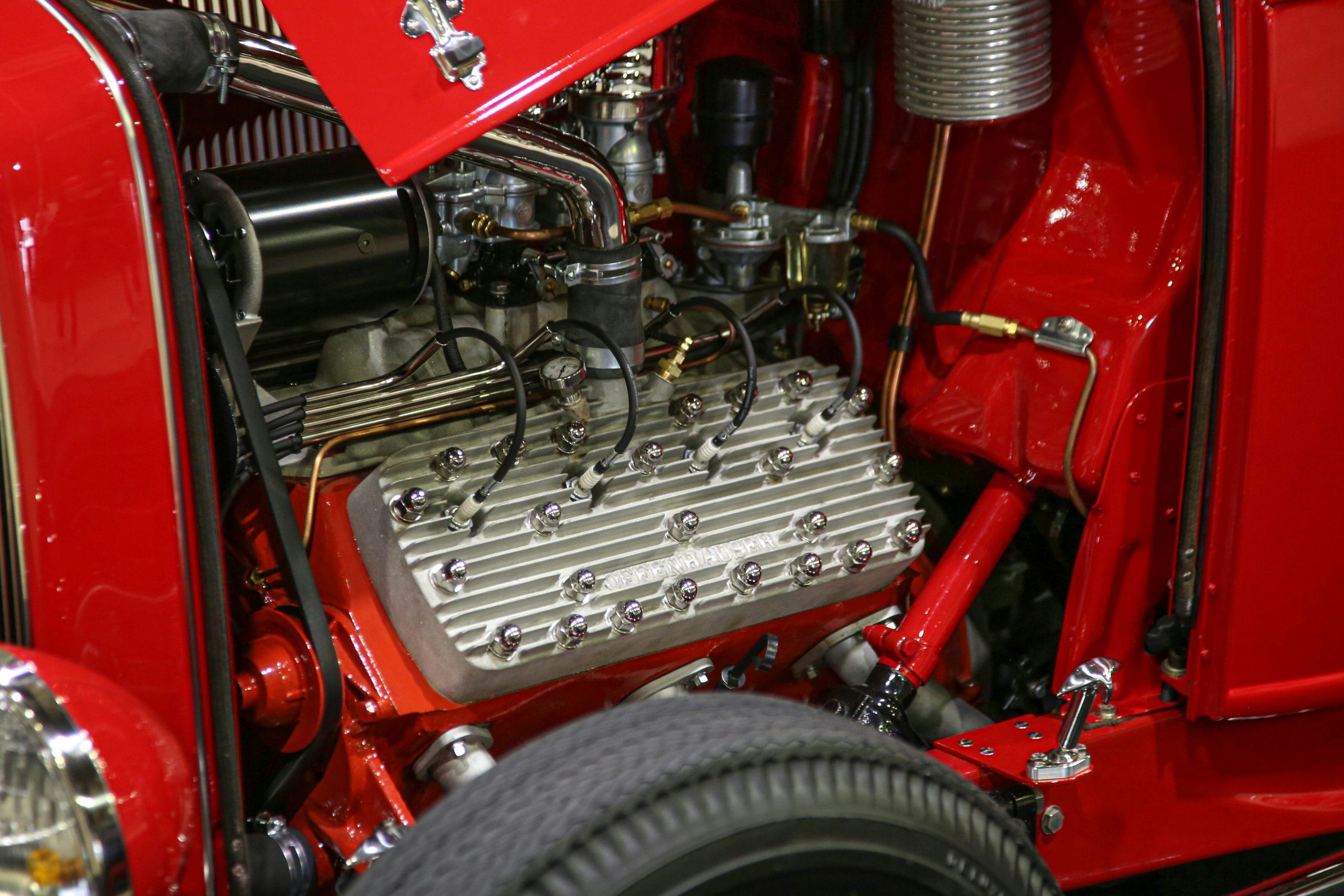Media | Articles
10 of our favorite Ford V-8s
2023 marks 120 years since Ford Motor Company was founded—on June 16, for you history buffs—and 20 years since Ford built its 100,000,000th V-8 engine. Since then, the company has made an increasing commitment to smaller, forced-induction engines. However, it certainly hasn’t given up on the V-8: The Blue Oval produced some of its best in the last 10 years.
Ford Motor Company’s 120th is a great time to look back at the company’s long history of building powerful V-8s, engines that won races, won customers, and even won wars.
Here are our favorite Ford engine families, with some standout models worth celebrating.
Flathead
1932–53 and beyond

This is where it all started. The Flathead wasn’t the world’s first V-8, and, with just 65 horsepower, it wasn’t the most powerful engine on the market in 1932, either. However, when the beautiful lines of the Ford Model 18 were met with the power of the compact Flathead V-8, the automotive world reached a milestone.
It’s hard to overstate the importance of the Flathead: In its wake, a whole industry of hot rod parts sprang up to feed racers’ need for speed. Even though the engine was phased out in the United States in 1954 in favor of the Y-block, the Flathead lived on elsewhere, notably in France and Brazil, where it was manufactured under license for passenger-car use into the ’60s. Even today, vintage hot-rod enthusiasts use the engine to power land-speed cars in classes that use the vintage castings—modern overseas castings aren’t allowed by the Southern California Timing Association.
Marketplace
Buy and sell classics with confidence
GAA V-8
1940–1960
Before the U.S. entered WWII, Ford began developing its own spin on Packard’s version of the Rolls-Royce Merlin V-12. The powerful Packard Merlin V-12s, supercharged for aircraft use, would be used in some of the most successful fighters of WWII, including the Supermarine Spitfire and North American P-51 Mustang. Unlike Rolls or Packard, Ford never built a V-12 for aircraft; it engineered the powerplant for tanks.
Ford developed a V-8 using the architecture of the Packard V-12 and the same 5.4-inch bore and 6-inch stroke. The result was a 1000-cubic-inch monster that served in a number of tanks and tanks destroyers such as the M4A3 Shermand and M10. Ford’s 500-hp V-8 was compatible with the same vehicles that used a pair of GM diesel engines. Ford did build full, V-12 versions of the engines for large tank prototypes toward the end of the war, but those twelve-cylinders never reached production.
By the way, these mid-century, DOHC engines use flat-plane crankshafts, so don’t let anyone tell you that the screaming 5.2-liter Voodoo was a first for Ford.
MEL
1958–67

Was there a better way to christen Ford’s newly minted Mercury-Edsel-Lincoln (MEL) division than with its own V-8 engine? Much like GM’s Buick, Oldsmobile, Cadillac, and Pontiac divisions, Ford decided MEL could have an engine significantly different than the FE (Ford-Edsel) engine introduced at the same time. While the MEL V-8 shared some internals (like oiling components) with the FE, the MEL was a shockingly unique design with “flat heads” that differ from those of the original Ford V-8.
Like its contemporaries, the MEL was an overhead valve design. However, while most engines of the era had cylinder heads with a combustion chamber machined into them, the MEL sported a space between the piston and the top of the cylinder’s bore, like Chevrolet’s W-series big-blocks did. From some angles that combustion chamber looks like a triangular wedge, not unlike the grille of the star-crossed Edsels that represent the “E” in MEL. Which clearly foretold a short and sad future for this engine.

For one shining moment, the MEL was the head of its class. The Super Marauder engine for 1958 sported three carburetors, an aluminum air cleaner, 430 cubic inches of displacement, and a shocking output of 400 horsepower. This was the first production engine to reach the magic horsepower number of 400, but Ford detuned it in 1959 and subsequently gave up the throne to other manufacturers. While Ford wised up and consolidated both its engine and vehicle-brand lineups, the loss of the MEL could only be eased by future big-block Ford V-8s.
FE
1958–76
Though Ford’s FE engine was built to power mid-size cars and light trucks, it evolved into several vastly different race-winning combinations. Initially launched as a 300-hp, 361-cubic-inch Edsel powerplant (FE stands for Ford-Edsel), the FE soon spread to Ford models in 332- and 352-cubic-inch displacements. However, you’re probably familiar with some of the larger displacements.
Ford’s 1-2-3 finish at the 1966 24 Hours of Le Mans came from three 427 FE–powered GT40s. The 390 that powered Lieutenant Frank Bullitt’s 1968 Mustang fastback was an FE. Shelby’s legendary 427 Cobra used an FE. Not bad bona fides for a performance V-8.
While Ford was already doing well in ’60s NASCAR competition against Chrysler’s 426 Hemi with their wedge FE cylinder heads, they still decided to get into the hemi game. It developed a single-overhead-cam version of the 427. The 427 SOHC was unfortunately banned from NASCAR competition but the few that were built saw use at the dragstrip.
From NASCAR superspeedways and NHRA drag strips to the Mulsanne Straight, the FE found success and brought home championships. It still has a niche aftermarket following and can be built into a formidable street or race engine.
Windsor
1960–2002
Ford’s compact OHV V-8 of the ’60s lived long enough to survive the malaise era and, as EFI took over for carburetors, the engine breathed life into a resurging performance market. We can’t pick one favorite from this fruitful family, which earned its nickname from its Canadian city of origin. K-Code 289s made a potent, high-winding package for early Mustang and Shelby GT350 road racers, and 1986’s sequential port fuel-injected 5.0 kicked off a performance industry of its own—who doesn’t love that fantastic, long-runer intake? In between those bookends is the yeoman 351, which served well in cars and trucks for decades.
Windsor V-8s were produced into the 21st century and used in Ford trucks. The Explorer was one of the last to use the engine, getting one of the best factory versions of the 302 using a potent set of heads that are prized by junkyard scroungers.

335 Series, aka Cleveland
1969–82
If you thought we forgot about the Boss 302, don’t worry. Known to enthusiasts as the “Clevor,” the famed Mustang Boss 302 engine was a melding of Windsor (bottom end) and Cleveland (top end). The two mills have the same bore spacing, so swapping on the big-valve Cleveland heads wasn’t a major undertaking. It was those free-breathing heads that made the engine special, so we’re including it here.
Although short-lived, the Cleveland engine family has a devoted aftermarket. The 351 and 400 engines in particular have great performance potential. The 10.297-inch deck height of the 351M and 400 Cleveland blocks makes it possible to drop in crankshafts with longer strokes, making either of these Clevelands a better candidate for a high-displacement small-block build than a 289 or 302 Windsor, each of which has a standard deck height of 9.2-inches, or even the 351 Windsor, whose deck height ranges from 9.48 to 9.503 inches (it grew taller in 1971). Ford fans in Australia love the Cleveland engine and some of the best aftermarket parts for these engines come from down under.
Indy V-8
1963–71
Lotus cars powered by Ford V-8s were some of the best-looking Indy cars of the 1960s. Displacing 256 cubic inches, the DOHC 90-degree V-8 was built to rev, and it sounded amazing. Its hot-V layout placed the intake runner between the camshafts and the exhaust ports in the valley between the heads, making for a beautiful exhaust system that was only practical in a mid-rear-engine design. In 1965, Jim Clark’s Ford-powered Lotus became the first mid-rear-engine car to win the Indianapolis 500, ending Offenhauser’s 18-year win streak.

385 Series
1968–98
Like the large-displacement big-blocks of Ford’s competitors, most of the 385 Series V-8s found their way into heavy passenger cars or 3/4- and 1-ton pickups, a workhorse role they filled into the 1990s, when the 460 V-8 was installed into scores of Super Duty trucks. However, the 385 Series—so named because of the 460 V-8’s 3.85-inch stroke—also gave birth to the 429 V-8, which used the same big, 4.36-inch bore but paired it with a 3.59-inch stroke.
The Boss 429 used the same bore and stroke combination but added monster heads with huge valves. Rather than placing all of the valves in a line, which is typically the case in wedge-shaped combustion chamber heads—shown below, on the left—the Boss 429 used hemispherical combustion chambers with valves canted away from each other. These rare V-8s are valuable collector’s pieces today, but aftermarket heads are now available to get the look and performance using a standard 385 Series bottom end.
Modular
1991–present

Plenty of Mustang enthusiasts were sad to see the 5.0 get replaced by the 4.6-liter two-valve, and we can’t blame them. When it launched, the Modular engine family didn’t have the huge aftermarket that the popular 5.0-liter Mustang GT had helped cultivate. In time, however, came better performing heads with three and eventually four valves per cylinder as well as increased displacement. The four-valve 4.6-liter was a solid performer, and plenty of drag racers have done impressive work with them, but it was the 5.0-liter Coyote that really cemented the Modular’s legendary status.
The 5.2-liter Voodoo engine found in the GT350 was the peak of naturally aspirated Modular performance at 526 hp. Swapping its flat-plane crank for a cross-plane piece and adding a massive supercharger created the 760-hp Predator engine found in the GT500. To this day, the Predator is Ford’s most powerful production engine.
Godzilla
2020–present

Ford has been all-in on OHC engines for passenger cars for decades, but it knew gasoline trucks need large displacement engines for making plenty of torque at low speeds. As the venerable 6.8-liter V-10 and 6.2-liter “Boss” SOHC V-8 were being phased out, a replacement was in order.
Enter “Godzilla,” a 7.3-liter monster that brings modern cylinder-head flow and precision manufacturing to a pushrod, two-valve V-8. In crate-engine form, it produces 430 hp and 475 lb-ft of torque. It is the largest V-8 currently produced by Ford and yet it has 4.53-inch bore spacing, meaning Godzilla is more of a small-block than a big-block.
We’re not sure how the aftermarket will respond to this engine, as it will be built in relatively low-volume due to its limited truck applications. That said, it’s still a big V-8, and all the usual hot-rodding tricks—like camshaft upgrades, cylinder head porting, and bolt-on exhaust headers—apply. We’re looking forward to seeing more of these engines under the hoods of classic Ford restomods in the future.
Those are our 10 favorite Ford engines, but of course, there are some that didn’t make the cut due to our arbitrary sense of taste. If you love either flavor of Y-Block, or perhaps a high-revving Ford NASCAR FR9 engine, make a case for it in the comments below.
***
Check out the Hagerty Media homepage so you don’t miss a single story, or better yet, bookmark it. To get our best stories delivered right to your inbox, subscribe to our newsletters.


































Another vote for the DFV, which I believe is still the single winningest engine in F1.
My 1st car was a 35 coupe for a $150. A bunch of us drove various flat heads of that era. The local
drag strip was a small airfield out in the boonies. We drove out, pulled the exhausts off and raced
all day. Then drove back to L.A. We flogged the cars as teens are want to do. Never failed
to make it home. Couldn’t afford the race mods, so you pulled the choke out part way and
it sounded like a race camshaft. The mechanical brakes were near worthless and taught me
leave a lot of room in front of me. Something I do to this day. Saved my bacon several times
over the 90 yrs. I’ve roamed the earth.
My 1st car was a 35 coupe for a $150. A bunch of us drove various flat heads of that era. The local
drag strip was a small airfield out in the boonies. We drove out, pulled the exhausts off and raced
all day. Then drove back to L.A. We flogged the cars as teens are want to do. Never failed
to make it home. Couldn’t afford the race mods, so you pulled the choke out part way and
it sounded like a race camshaft. The mechanical brakes were near worthless and taught me to
leave a lot of room in front . Something I do to this day. Saved my bacon several times
over the 90 yrs. I’ve roamed the earth.
The Windsor is listed as living until 2002, but it was actually killed off when the 02 explorer dropped. 01 was the last year of the Windsor 302. Available only in the 4 door explorer with 2wd, 4wd, and AWD available. Some even came with an 8.8 rear with disc brakes, a sleeper when it comes to junk yard rear ends.
The Windsor made it one more year in Australia.
The only thing I would add is that the Windsor resurgence actually started in the 80’s, not the 90’s. The return of the HO 5.0 in 82, and the subsequent power increases every year are where it began.
In high school (very late ’50’s) Dad bought me a used 4-door ford (don’t remember model) – 3-on-the-tree, 292, 2-barrel. Ran pretty good – could give a 348 checy a decent run – long story short I ended up with 4-barrel and manifold off of a ’58 352 “police interceptor”. Walked the dog for 2 years – nobody beat me until the Natchitoches police got their first 390 patrol car – tracked me down to run them and they barely beat me. During a teardown/rebuild (collapsed rings) went to replace the beat-up cam shaft and discovered what the dealer said at first was not a ford cam – but it had a ford part number – turned out the car was originally ordered by a Louisiana state trooper for himself with a “marine cam”. Woeked really well until in met a black angus one night.
I love the 351 Windson V8 in my 1969 Shelby GT350. Smooth acceleration and sounds great with the exhaust cut-outs wide open.
Happy to see a few mention the Y-Block, although forgotten by most of the younger crowd it was a fine engine in it’s own right. Any bad reputation that it may have acquired over the years was only a result of bad lubricants and bad maintenance. They made good power stock and respond well to modifications. They also have a very nice tone to the exhaust, especially at 7000 rpm.
I have a 2018 mustang gt with a coyote with the active exhaust, love that V8 sound!mark
Respect for mod motors, 2v and Coyote. I only have built on my own SBF and BBF. SBF are pound for pound hard to beat, however the 5.0 Coyote is what you want today in terms of power. I favor the old school, but even old dogs can be taught new tricks.
The Windsor is probably my favorite as it is the engine of my youth in all the Mustangs, etc. that I saw it in.
It depends what your interest is in an engine. To be MEL and FE motors were some of the greatest engines made by any manufacturer. No engines ran as smooth and as quiet as these engines. You could put your hand on the valve cover with the engine running and feel no vibration whatsoever. In the 50’s and 60’s when most cars ate camshafts, timing chains and rockers besides valve jobs and rings these engines suffered zero problems. I own 25 cars with MELs and FEs and they all run like Swiss watches. They only problem they had was valve seals and exhaust manifold leaks. Big deal! They are great motors. The only motor to hold a candle to these engines was the Buick Nailhead.
Wasn’t there also a 360 FE used in trucks in the 70’s?
Kind of a scattershot history in the story. Left out a lot. Thanks goodness for the replies to fill it in
Where’s the winningest F1 engine of all time??